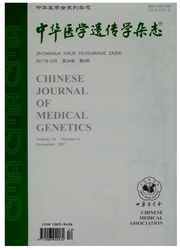

 中文摘要:
中文摘要:
目的构建并筛选针对帕金森病致病基因α-synuclein特异、高效的RNA干扰载体,观察应用RNA干扰技术阻断α-synuclein过表达导致α-synuclein蛋白病理性积聚的作用。方法采用携带Hl启动子的PBSHHl质粒,设计并构建针对α-synuclein基因4个可有效表达发夹状RNA的特异性α-synuclein基因干扰载体pSVNi-1、pYNi-2,pSYNi-3、pSVNi-4,通过限制性内切酶酶切、DNA测序证实后,转染HEK293细胞,应用Western印迹、逆转录-PCR观察干扰载体的有效性,筛选特异、高效的RNA干扰载体。采用脂质2000将筛选的最佳α-synuclein-pBSHI RNA干扰载体及野生型α-synuclein-pEGFP真核细胞表达载体共转染HEK293细胞,并设立对照组,48h后采用Axiovert200型倒置荧光显微镜、荧光免疫细胞化学观察其在细胞内的表达,HE染色观察细胞质内嗜酸性小体的形成。结果Western印迹、逆转录-PCR结果显示,pS,CNi-1载体具有高效的RNA干扰抑制作用,效率达69.6%;将α-synuclein-pBSHHl RNA干扰载体pSYNi-1及野生型α-synuclein-pEGFP真核细胞表达载体转染HEK293细胞,48h后荧光显微镜下观察细胞在波长488nm蓝色激发光下发出明亮的绿色荧光,其中对照组某些细胞质内出现绿色荧光物质积聚,而转染psyni-1干扰组细胞质内绿色荧光物质分布均匀;免疫荧光细胞化学检测结果显示,转染48h后对照组可见α-synuclein免疫阳性产物在胞浆内聚集,转入RNA干扰载体pYNi-1后胞浆内α-synuclein免疫阳性产物分布均匀;HE结果显示,转染48h后,对照组某些细胞质内出现圆形的嗜酸性小体(类Lewy小体)形成;转入RNA干扰载体pSVNi-1后胞浆内未见类Lewy小体形成。结论RNA干扰技术通过抑制α-synuclein基因的表达,成功阻断了野生型α-synuclein过表达所诱导的α-synuclein蛋白病理性积聚,为最终应用RNA干扰技术临床治疗帕金森病提供了某些依据。
 英文摘要:
英文摘要:
Objective To construct specific and effective RNA interference(RNAi) plasmid for α-synuclein gene and investigate RNAi blockade of the aberrant aggregation of α-synuclein in HEK293 cells induced by overexpression of wild-type α-synuclein. Methods Hairpin RNAs for four target sites were designed to construct four RNAi plasmids pSYNi-1, pSYNi-2, pSYNi-3 and pSYNi-4, using plasmid pBSHH1 vector under the control of the H1 promoter. Westem blot and reverse tmnscription-PCR(RT-PCR) weie performed to screen the most specific and effective RNAi plasmid. After confirming the sequences of the plasmids, they weie co-transfected into HEK293 cells with the recombinant plasmids α-synuclein-pEGFP by using lipofectamin 2000. The aberrant aggregation of α-synuclein was measured by EGFP fluorescence and immunocytochemistry for α-synuclein. The inclusions in the cultured cells were identified with HE staining. Results By Western blot and RT-PCR, pSYNi-1 showed the most effective RNAi gene silencing effect (69.6 % ). After transfecting the RNAi plasmid, the aberrant aggregation of α-synuclein in HEK293 cells induced by overexpression of wild-type α-synuclein was inhibited. The Lewy body-like inclusions were found in cytoplasm of cultured cells in control group, but disappeared in HEK293 cells cotransfected by pSYNi-1 and α-synuclein-pEGFP plasmid. Conclusion RNAi can block the aberrant aggregation and Lewy body-like inclusion formation in cytoplasm of HEK293 cell induced by overexpression of wild-type α-synuclein.
 同期刊论文项目
同期刊论文项目
 同项目期刊论文
同项目期刊论文
 期刊信息
期刊信息
